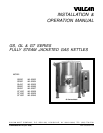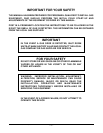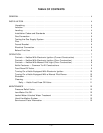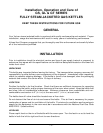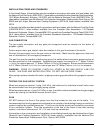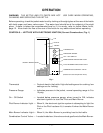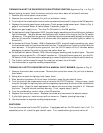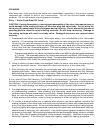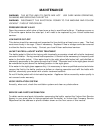
– 5 –
INSTALLATION CODES AND STANDARDS
In the United States, Vulcan kettles must be installed in accordance with state and local codes, with
the National Fuel Gas Code, (ANSI-Z223.1, latest edition) available from the American Gas Association,
1515 Wilson Boulevard, Arlington, VA 22209, with the National Electrical Code (ANSI/NFPA No. 70,
latest edition) available from the National Fire Protection Association, Batterymarch Park, Quincy, MA
02269 and with
Vapor Removal from Cooking Equipment
,
(NFPA-96, latest edition) available from
NFPA.
In Canada, the kettle must be installed in accordance with local codes, with the National Fuel Gas Code
(CAN/CGA-B149.1, latest edition) available from the Canadian Gas Association, 178 Rexdale
Boulevard, Etobicoke, Ontario, Canada M9W 1R3, and with the Canadian Electrical Code (CSA C22.2
No.3, latest edition) available from the Canadian Standards Association, 178 Rexdale Boulevard,
Etobicoke, Ontario, Canada M9W 1R3.
GAS CONNECTION
The gas supply connection and any pipe joint compound must be resistant to the action of
propane gases.
Codes require that a gas shutoff valve be installed in the gas line ahead of the kettle.
Connect the gas supply line to the gas valve on the kettle. Make sure the pipes are clean and
free of obstructions, dirt and piping compound.
The gas line must be capable of delivering gas to the kettle without excessive pressure drop at
the rate specified on the nameplate. Suggested gas supply line pressure is 7" Water Column
(
1.75 kPa) for natural gas and 11" Water Column (2.75 kPa) for propane. Burner manifold pressure
is 3.5" Water Column (
0.875 kPa) for natural gas and 10" Water Column (2.5 kPa) for propane.
WARNING: PRIOR TO LIGHTING, CHECK ALL JOINTS IN THE GAS SUPPLY LINE FOR
LEAKS. USE SOAP AND WATER SOLUTION. DO NOT USE AN OPEN FLAME.
After piping has been checked for leaks, all piping receiving gas should be fully purged to remove
air.
TESTING THE GAS SUPPLY SYSTEM
When test pressures exceed
1
⁄2 psig (3.45 kPa), the kettle and its individual shutoff valve must
be disconnected from the gas supply piping system.
When test pressures are
1
⁄2 psig (3.45 kPa) or less, the kettle must be isolated from the gas supply
system by closing its individual manual shutoff valve.
FLUE
DO NOT obstruct the flow of flue gases from the flue located on the rear of the kettle. It is
recommended that the flue gases be ventilated to the outside of the building through a ventilation
system installed by qualified personnel. The flue on the kettle should not be directly connected
to any ventilation system. From the termination of the flue to the filters of the hood venting
system, a minimum clearance of 18" (116 cm) must be maintained.
Information on the construction and installation of ventilating hoods may be obtained from
Vapor
Removal from Cooking Equipment
, NFPA-96 (latest edition), available from the National Fire
Protection Association, Batterymarch Park, Quincy, MA 02269.



